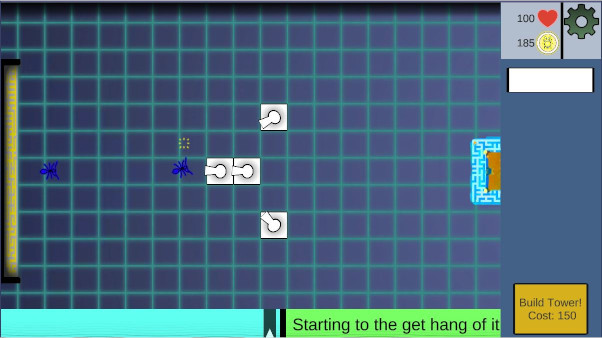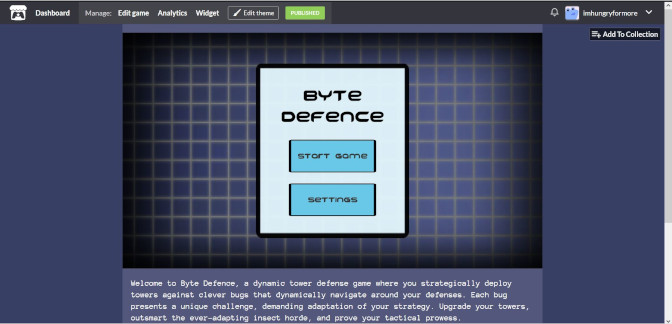Byte Defence
- GitHub: Link to the Repository
- Itch.io: Link to the game
- Created: March 2023 - December 2023
- Game Engine: Unity (C#)
- Other Software: GIMP (sprites)


I began developing Byte Defence in spring of 2023 on Unity when one of my friends gave me the idea to develop a tower defence game. I worked on it mostly during classes and breaks while studying at Metropolia. I then took a break from it because the studies became more intensive, and I didn’t have enough free time to work on it.
It was during this time I learned about pathfinding algorithms. For this project I decided to try to implement a pathfinding algorithm called A*. The idea was to make a classic tower defence game where player can place a tower anywhere and enemies find their path around towers, but I didn’t want to use the built in pathfinding in Unity. This made this project an interesting coding task. I found this great website where A* was created for Python and I simply implemented it into Unity. At the time I didn’t understand the differences between pathfinding algorithms, so I thought I was making A* but I what I really did was breadth-first search (BFS). It works perfectly fine for this but A* is more optimal. Here is how the pathfinding works:
// Initialize pathpoint list with endpoint at start
List points = new()
{
endPoint
};
// Determine positions of pathpoints
float xPos = startingXPosition;
float yPos = 0f;
// Determine x and y indexes
int yIndex = 0;
int xIndex = 0;
// Continue loop until yPos is over both top and bot mapHeight
while (MathF.Abs(yPos) <= mapheight - topYPosOffset || MathF.Abs(yPos) <= mapheight - botYPosOffset)
{
if ((yPos >= 0 && yPos <= mapheight - topYPosOffset) ||
(yPos < 0 && yPos >= -(mapheight - botYPosOffset)))
{
while (xPos >= -mapwidth)
{
xIndex++;
points.Add(CreatePathpoint(new Vector3(xPos, yPos), new PathfindingID(xIndex, yIndex)));
xPos -= positionStep;
}
}
xPos = startingXPosition;
xIndex = 0;
if (yPos > 0)
{
yPos *= -1f;
yIndex *= -1;
}
else
{
yPos = Math.Abs(yPos) + positionStep;
yIndex = Math.Abs(yIndex) + 1;
}
}
pathPoints = points.ToArray();
First the code creates a grid of ‘PathPoints’ and inserting end point as first value. Each PathPoint is given an index value for both x and y. These indices represent how far given point is from end point.
///
/// Determine neighbours for pathpoints
///
///
/// neighbours = new();
for (int i = 0; i < pathPoints.Length; i++)
{
int xDifference = Math.Abs(pathPoints[i].ID.x - currentPoint.ID.x);
int yDifference = Math.Abs(pathPoints[i].ID.y - currentPoint.ID.y);
// If pathpoint is directly LEFT, RIGHT, UP, DOWN, or DIAGONAL
// Add it as a neighbour
if ((xDifference == 1 && yDifference == 0) || // Horizontal
(xDifference == 0 && yDifference == 1) || // Vertical
(xDifference == 1 && yDifference == 1)) // Diagonal
{
neighbours.Add(pathPoints[i]);
}
}
return neighbours.OrderBy(p => Mathf.Abs(p.ID.x) + Mathf.Abs(p.ID.y)).ToArray();
}
After every PathPoint is created, the code iterates through it once again to determine neighbours. Neighbours are the key to determining the pathfinding. The neighbours are sorted based on how close they are to (0, 0).
///
/// Calculate pathfinding
///
private void RecalculateDistancesAStar()
{
// Create queue and dictionary with the first point as first value
// Dictionary value is int (number of steps from start)
Queue frontier = new();
frontier.Enqueue(pathPoints[0]);
Dictionary pathPointChecked = new()
{
{ pathPoints[0], 0 }
};
// As long as there is a pathpoint to check, continue on checking
while (frontier.Count > 0)
{
// Get the next pathpoint from queue
PathPoint current = frontier.Dequeue();
// Get it's neighbours and go through them
PathPoint[] currentNeighbours = current.Neighbours;
foreach (PathPoint pathPoint in currentNeighbours)
{
// If this neighbouring pathpoint has not been already been checked and is pathable
if (!pathPointChecked.ContainsKey(pathPoint) && pathPoint.IsPathable)
{
// Enqueue to check this pathpoints to check it
frontier.Enqueue(pathPoint);
// Add it to dictionary and save it's own distance with current pathpoint distance + 1
pathPointChecked.Add(pathPoint, 1 + current.StepsFromEnd);
pathPoint.SetDistanceToEnd(1 + current.StepsFromEnd, exitPointSize);
// Scales the exit to contain pathpoints
if (!isEndObjScaled && pathPoint.IsCloseToExit)
{
DetermineEndPointDimensions(pathPoint.transform.position);
}
}
}
}
isEndObjScaled = true;
}
This function determines the distance for each PathPoint and its neighbours to the end. Once player places a tower, PathPoints that are under the tower are disabled and this function determines a new path to follow. This system works but it’s not the most optimal pathfinding algorithm. If I decide to make a sequel to Byte Defence, improving the pathfinding algorithm is one of the first tasks.
After selecting game studies as my major, I had a hard time coming up with a game that I wanted to do. Eventually, I decided to continue my old tower defence project that I had dropped. During spring, I coded the game very sloppily, and as I was revisiting it, I had to spend much more time in refactoring and optimizing than I had anticipated. At the start, I had planned a lot of unique gameplay elements, like abilities and environmental hazards, but ended up dropping most of them due to being forced to spend so much time on refactoring.

I was also surprised on how much time I had to spend on playtesting. Tower defence games are slow by their nature, and they have a lot of different strategies attached to them, making playtesting hard and time consuming. Luckily, I had many helpful playtesters that happily played and gave valuable feedback.
I created virtually every asset in this game, handling everything from coding to crafting sprites. I'm thrilled with the outcome, both in terms of aesthetics and gameplay. However, I never want to create or even touch Unity Ui elements ever again. Coding and designing Ui in Unity is horrible. Despite of that, during this project I grew to have more appreciation for 2D art. It’s fun!

I released the final version (hopefully) 12th of December 2023. I learned a lot during this project about coding and game design. You can play the game at Itch.io